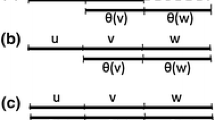Abstract
The restriction enzyme is an important device which provides cutting operations of DNA strands to construct a DNA-based computational model such as splicing systems [3]. In this paper, we employ a specific type of restriction enzyme which cut on both sides of their recognition sequences [6], and propose a new DNA-based computational model which has several advantages compared with conventional models. The new computational model is shown to achieve universal computability using only natural DNA-based methods such as annealing, cut, ligation and circular strands without any practically hard assumption. Furthermore, while the generative power of the computational model is shown to be universal, the parsing (accepting) computation ability is more appealed. That is, given any string, the model computes whether it accepts the string, and most conventional DNA-based model have not offer this accepting process. We show that the new computational model efficiently computes the parsing process for context-free grammars and finite sequential transducers.
Access this chapter
Tax calculation will be finalised at checkout
Purchases are for personal use only
Preview
Unable to display preview. Download preview PDF.
Similar content being viewed by others
References
Y. Benenson, T. Paz-Ellzur, R. Adar, E. Keinan, Z. Livneh, and E. Shapiro. Programmable and autonomous computing machine made of biomolecules. Nature, 414, 430–434, 2001.
S.K. Degtyarev, N.I. Rechkunova, Y.P. Zernov, V.S. Dedkov, V.E. Chizikov, M. Van Calligan, R. Williams, and E. Murray. Bsp24I, a new unusual restriction endonuclease. Gene, 131, 93–95, 1993.
T. Head. Formal language theory and DNA: An analysis of the generative capacity of specific recombinant behaviors. Bulletin of Mathematical Biology, 49, 737–759, 1987.
L. Kari and G. Thierrin. Contextual insertion/deletion and computability. Information and Computation, 131, 47–61, 1996.
Gh. Păun, G. Rozenberg, and A. Salomaa. DNA Computing. Springer-Verlag, Heidelberg, 1998.
Author information
Authors and Affiliations
Editor information
Editors and Affiliations
Rights and permissions
Copyright information
© 2003 Springer-Verlag Berlin Heidelberg
About this paper
Cite this paper
Sakakibara, Y., Imai, H. (2003). A DNA-based Computational Model Using a Specific Type of Restriction Enzyme. In: Hagiya, M., Ohuchi, A. (eds) DNA Computing. DNA 2002. Lecture Notes in Computer Science, vol 2568. Springer, Berlin, Heidelberg. https://doi.org/10.1007/3-540-36440-4_28
Download citation
DOI: https://doi.org/10.1007/3-540-36440-4_28
Published:
Publisher Name: Springer, Berlin, Heidelberg
Print ISBN: 978-3-540-00531-5
Online ISBN: 978-3-540-36440-5
eBook Packages: Springer Book Archive




